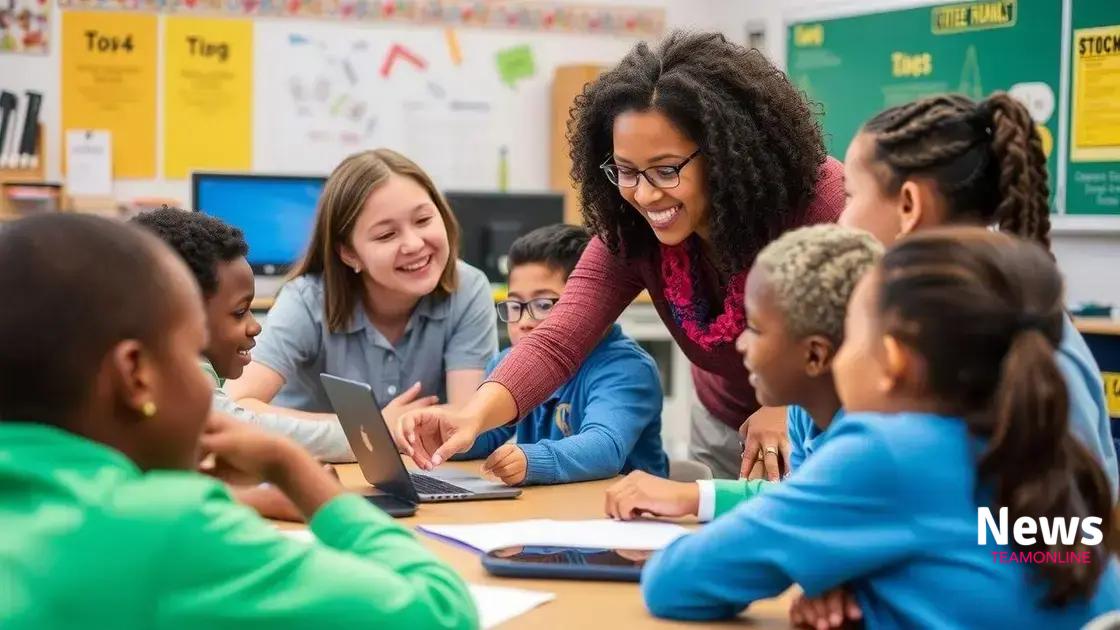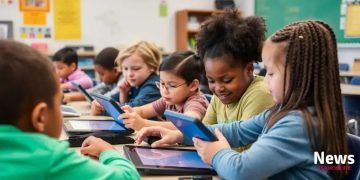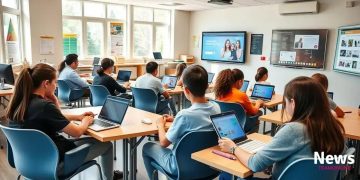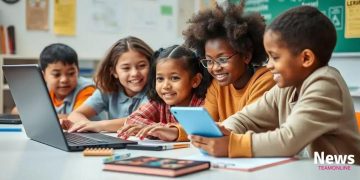Inclusive education: strategies for supporting diverse learners

Inclusive education involves teaching diverse learners in the same environment, utilizing varied strategies and assessments to meet individual needs and foster a sense of belonging for all students.
Inclusive education plays a vital role in creating equitable learning environments for all students, regardless of their backgrounds or abilities. Have you thought about how these strategies can transform classrooms into more supportive spaces? Let’s dive into some effective approaches.
Understanding inclusive education
Understanding inclusive education is crucial for fostering an environment where all students can thrive. It ensures that learners from diverse backgrounds, including those with disabilities, receive equitable opportunities to succeed in school.
What is Inclusive Education?
Inclusive education means that all students, no matter their abilities or backgrounds, learn together in the same environment. This approach promotes acceptance and respect among peers, enhancing the overall classroom experience.
Key Principles of Inclusive Education
- Respect for diversity: Every student’s unique needs and strengths are valued.
- Access to the curriculum: All students can participate in their education.
- Supportive learning environment: Teachers and staff provide the necessary resources for success.
By embracing these principles, teachers can create a supportive atmosphere that benefits everyone. For instance, students learn to appreciate differences, fostering friendship and cooperation.
Inclusive classrooms focus on collaboration. Teachers often use group work and peer mentoring to enhance learning. This method helps students learn from one another and develop essential social skills.
Benefits of Understanding Inclusive Education
Understanding inclusive education benefits not only students with specific needs but also their peers. For example, students who learn in inclusive settings often show improved academic performance and social skills.
- Stronger communication skills: Students engage more with their classmates.
- Emotional resilience: Learners develop empathy and understanding.
- Better problem-solving abilities: Diverse perspectives encourage creative thinking.
In conclusion, inclusive education nurtures a sense of belonging and enhances the educational experience for all learners. As we continue to develop inclusive strategies, we foster a more equitable world for everyone.
Benefits of inclusive education for all students
The benefits of inclusive education extend far beyond just accommodations for students with disabilities. This approach creates a richer learning environment for everyone involved, fostering a sense of community and belonging.
Improved Academic Outcomes
Studies show that students in inclusive settings tend to achieve better academic results. This occurs because diverse learning styles are encouraged, allowing students to engage with the material in ways that suit their needs. Teachers can utilize varied instructional strategies to reach all learners effectively.
Enhanced Social Skills
In inclusive classrooms, students learn to communicate and collaborate with peers from diverse backgrounds. This interaction helps them develop strong social skills.
- Students learn empathy by understanding different perspectives.
- Participation in group activities promotes teamwork.
- Diverse interactions lead to better communication abilities.
These experiences prepare students for life beyond school, as they interact with a wide range of individuals in society.
Increased Self-Esteem
Inclusive education supports positive self-esteem among all students. When children feel valued and accepted, they are more likely to participate and express themselves. This confidence encourages taking risks in their learning.
- Feeling included promotes a sense of belonging.
- Recognition of achievements boosts self-worth.
- Peer support helps build resilience.
As students celebrate each other’s successes, they foster a positive environment that nurtures personal growth.
Preparation for Real-World Challenges
In today’s world, it’s crucial for students to learn alongside diverse peers. Inclusive education equips students with skills necessary to navigate life in a multicultural society. This exposure prepares them for success in various professional fields.
Inclusive education builds a foundation of acceptance and understanding. By recognizing the strengths of each individual, the classroom becomes a place where everyone can contribute effectively and learn from one another.
Practical strategies for teaching diverse learners

Teaching diverse learners requires effective strategies to meet different needs in the classroom. Implementing practical strategies can help educators engage all students and create an inclusive learning environment.
Utilize Differentiated Instruction
Differentiated instruction is essential for addressing the varied learning styles of students. By adjusting the teaching methods, you can tailor lessons to fit the strengths and weaknesses of each learner.
- Adjust the content based on students’ readiness levels.
- Vary the process used to teach the material.
- Offer different products for students to demonstrate their understanding.
This approach not only supports individual learning but also encourages growth among all students.
Incorporate Technology
Technology can be a powerful tool in supporting diverse learners. Using educational software and online resources allows for personalized learning experiences.
- Interactive apps can engage students and provide immediate feedback.
- Online platforms offer resources that cater to various learning styles.
- Assistive technologies can help students with disabilities access the curriculum.
Incorporating technology increases student engagement and fosters independence.
Create Collaborative Learning Opportunities
Group work promotes learning through collaboration. Allowing students to work together encourages them to share ideas and learn from one another.
Consider forming diverse groups that mix students of different abilities. This creates mentorship opportunities, helping stronger learners support those who may struggle.
Collaborative projects foster communication skills and build friendships, creating a supportive classroom atmosphere.
Establish a Positive Classroom Environment
Building a positive classroom environment is vital for teaching diverse learners. Ensure that the classroom is welcoming and safe for open discussions. Establishing clear expectations promotes respect among students.
Encouragement and praise can motivate students to take risks and engage with their learning. By celebrating successes, no matter how small, you foster confidence and a growth mindset.
Creating an inclusive classroom environment
Creating an inclusive classroom environment is essential for fostering learning that respects and values all students. An inclusive classroom considers the diverse needs of learners, promoting a sense of belonging for everyone.
Physical Space and Setup
The physical layout of the classroom plays a significant role in inclusivity. Ensure that the space is accessible for all students, including those with mobility issues. Desks should be arranged to promote collaboration while allowing for easy movement.
Consider incorporating areas for various learning activities. For instance, designating quiet spaces for concentration helps students who may need a break from the stimulation of group work.
Cultivating Respect and Empathy
Building a culture of respect is crucial in an inclusive classroom. Start by setting clear expectations for behavior and communication. Encourage students to value differences by highlighting the unique strengths each individual brings.
- Implement activities that promote teamwork.
- Encourage sharing of personal experiences to foster understanding.
- Model empathetic behavior in interactions.
When students learn to appreciate one another, they contribute to a more positive classroom climate.
Incorporating Diverse Teaching Strategies
Using a variety of teaching strategies is key to addressing the needs of all learners. Incorporate visual, auditory, and kinesthetic methods to present information effectively. This variety ensures that every student has an opportunity to engage with the material in a way that suits them best.
Group activities that align with students’ interests can boost motivation and participation. Providing choices in how students demonstrate learning also empowers them and encourages a love for learning.
Engaging Families and Communities
Engaging families in the educational process strengthens the inclusive environment. Communicate regularly with parents about their children’s progress and ways they can support learning at home.
Consider hosting community events that involve families and celebrate cultural diversity, allowing students to share their backgrounds and traditions. These connections create a sense of community that extends beyond the classroom.
Assessing progress in diverse learning contexts
Assessing progress in diverse learning contexts is vital for understanding how well students are meeting their educational goals. Effective assessment strategies ensure that every student’s unique needs are addressed, promoting a more inclusive learning environment.
Multiple Assessment Methods
Using various assessment methods allows educators to capture a complete picture of student understanding. This includes traditional tests, projects, and even informal observations. Each method serves to highlight different strengths.
- Standardized tests measure basic skills and knowledge.
- Project-based assessments evaluate application and critical thinking.
- Observations help understand student engagement and social interactions.
Combining these approaches creates a well-rounded assessment strategy that supports diverse learners.
Formative vs. Summative Assessment
Understanding the difference between formative and summative assessments is key. Formative assessments are ongoing and used to monitor student learning. This allows for real-time feedback, which can be critical in adapting lessons to meet student needs.
On the other hand, summative assessments occur at the end of an instructional period. They evaluate overall student learning. Both types are essential, as they provide insights into student progress and effectiveness of instruction.
Culturally Responsive Assessment
Culturally responsive assessment takes into account the diverse backgrounds of students. It is essential to ensure that assessments are fair and equitable. Using culturally relevant materials can help students feel more engaged and understood.
Examples of this include using texts and examples that reflect the students’ cultures, which encourages more authentic participation.
Utilizing Student Feedback
Getting feedback from students about their learning experiences is invaluable. Surveys, one-on-one discussions, and peer reviews provide insight into their perceptions of the learning process. This allows educators to adjust instructional methods to better suit diverse needs.
Incorporating student voice not only empowers learners but also fosters a sense of ownership over their education.
FAQ – Frequently Asked Questions about Inclusive Education
What is the importance of an inclusive classroom environment?
An inclusive classroom environment fosters belonging, engagement, and respect among all students, helping them to thrive academically and socially.
How can I assess the progress of diverse learners?
Assess progress using various methods such as tests, projects, and observations. This approach captures a comprehensive view of each student’s learning.
What strategies can I use to support diverse learning needs?
Implement differentiated instruction, utilize technology for personalized learning, and create opportunities for collaboration among students.
How can family engagement benefit inclusive education?
Engaging families enhances student support, provides essential feedback, and creates a community that extends learning beyond the classroom.





